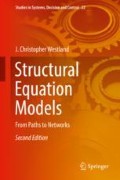Abstract
The hypothetico-deductive model pioneered by Galileo is commonly received as the ideal research standard. But, in many situations it may not be feasible to implement every aspect of that approach. This chapter surveys the objectives of research and the various approaches that might be pursued to answer specific questions in pursuit of research objectives. This chapter considers the role of statistics, causality, risk, alternative models, Neyman–Pearson hypothesis testing, and other factors in pursuit of publishable research.
Access this chapter
Tax calculation will be finalised at checkout
Purchases are for personal use only
References
Barabasi, Albert-Laszlo, and Zoltan N. Oltvai. 2004. “Network Biology: Understanding the Cell’s Functional Organization.” Nature Reviews Genetics 5 (2): 101.
Bennett, Craig M., George L. Wolford, and Michael B. Miller. 2009. “The Principled Control of False Positives in Neuroimaging.” Social Cognitive and Affective Neuroscience 4 (4): 417–422.
Box, George E.P., and Norman R. Draper. 2007. Response Surfaces, Mixtures, and Ridge Analyses. Vol. 649. Hoboken: Wiley.
Chen, Feinian, Kenneth A. Bollen, Pamela Paxton, Patrick J. Curran, and James B. Kirby. 2001. “Improper Solutions in Structural Equation Models: Causes, Consequences, and Strategies.” Sociological Methods & Research 29 (4): 468–508.
Cochran, William G., Frederick Mosteller, and John W. Tukey. 1954. “Principles of Sampling.” Journal of the American Statistical Association 49 (265): 13–35.
Freedman, David A. 1987. “As Others See Us: A Case Study in Path Analysis.” Journal of Educational Statistics 12 (2): 101–128.
Freedman, David H. 2010. “Lies, Damned Lies, and Medical Science.” The Atlantic 306 (4): 76–84.
Goodhue, Dale, William Lewis, and Ron Thompson. 2006. “PLS, Small Sample Size, and Statistical Power in Mis Research.” In Proceedings of the 39th Annual Hawaii International Conference on System Sciences, 2006. Hicss’06. Vol. 8, 202b. Piscataway: IEEE.
Gould, Stephen Jay. 1977. Ontogeny and Phylogeny. Cambridge: Harvard University Press.
Gross, Paul R., and Norman Levitt. 1997. Higher Superstition: The Academic Left and Its Quarrels with Science. Baltimore: JHU Press.
Harris, R.L. 1999. Information Graphics: A Comprehensive Illustrated Reference. Oxford: Oxford University Press. http://books.google.com/books?id=LT1RXREvkGIC
Hill, Bruce M. 1979. “Posterior Moments of the Number of Species in a Finite Population and the Posterior Probability of Finding a New Species.” Journal of the American Statistical Association 74 (367): 668–673.
Hume, David. 1758. Essays and Treatises on Several Subjects. Edinburgh: A. Millar, A. Kincaid, A. Donaldson.
Ioannidis, J.P.A. 2005a. “Why Most Published Research Findings Are False.” PLoS Medicine 2 (8): e124.
———. 2005b. “Differentiating Biases from Genuine Heterogeneity: Distinguishing Artifactual from Substantive Effects.” In Publication Bias in Meta-Analysis: Prevention, Assessment and Adjustments, 287–302. Chichester: Wiley.
Kline, Rex B. 1998. “Software Review: Software Programs for Structural Equation Modeling: Amos, Eqs, and Lisrel.” Journal of Psychoeducational Assessment 16 (4): 343–364.
Liberati, Alessandro, Douglas G. Altman, Jennifer Tetzlaff, Cynthia Mulrow, Peter C. Gøtzsche, John P.A. Ioannidis, Mike Clarke, Pl J. Devereaux, Jos Kleijnen, and David Moher. 2009. “The Prisma Statement for Reporting Systematic Reviews and Meta-Analyses of Studies That Evaluate Health Care Interventions: Explanation and Elaboration.” PLoS Medicine 6 (7): e1000100.
McCarthy, Mark I., Gonçalo R. Abecasis, Lon R. Cardon, David B. Goldstein, Julian Little, John P.A. Ioannidis, and Joel N. Hirschhorn. 2008. “Genome-Wide Association Studies for Complex Traits: Consensus, Uncertainty and Challenges.” Nature Reviews Genetics 9 (5): 356.
Merton, R.K. 1968. “The Matthew Effect in Science.” Science 159 (3810): 56.
Merton, Robert K. 1988. “The Matthew Effect in Science, Ii: Cumulative Advantage and the Symbolism of Intellectual Property.” Isis 79 (4): 606–623.
———. 1995. “The Thomas Theorem and the Matthews Effect.” Social Forces 74 (2): 379–424.
Merton, Robert King, and Robert C. Merton. 1968. Social Theory and Social Structure. New York City: Simon and Schuster.
Michotte, Albert, and Georges Thines. 1991. “Perceived Causality.” In Michotte’s Experimental Phenomenology of Perception, 66–87. East Sussex: Lawrence Erlbaum Hove.
Noonan, Richard, and Herman Wold. 1982. “PLS Path Modeling with Indirectly Observed Variables: A Comparison of Alternative Estimates for the Latent Variable.” In Systems Under Indirect Observation, Part II. Amsterdam: North Holland.
Scheines, Richard, Peter Spirtes, Clark Glymour, Christopher Meek, and Thomas Richardson. 1998. “The Tetrad Project: Constraint Based Aids to Causal Model Specification.” Multivariate Behavioral Research 33 (1): 65–117.
Sokal, Alan D. 1996. “Transgressing the Boundaries: Toward a Transformative Hermeneutics of Quantum Gravity.” Social Text, no. 46/47: 217–252.
Sokal, Alan D., and Jean Bricmont. 1998. Intellectual Impostures: Postmodern Philosophers’ Abuse of Science. London: Profile Books.
Stigler, Stephen M. 1980. “Stigler’s Law of Eponymy.” Transactions of the New York Academy of Sciences 39 (1 Series II): 147–157.
Tabachnick, Barbara G., Linda S. Fidell, and Jodie B. Ullman. 2007. Using Multivariate Statistics. Needham Heights: Allyn & Bacon/Pearson Education.
———. 2002b. A New Kind of Science. Vol. 5. Champaign: Wolfram Media.
Author information
Authors and Affiliations
Rights and permissions
Copyright information
© 2019 Springer Nature Switzerland AG
About this chapter
Cite this chapter
Westland, J.C. (2019). Research Structure and Paradigms. In: Structural Equation Models. Studies in Systems, Decision and Control, vol 22. Springer, Cham. https://doi.org/10.1007/978-3-030-12508-0_7
Download citation
DOI: https://doi.org/10.1007/978-3-030-12508-0_7
Published:
Publisher Name: Springer, Cham
Print ISBN: 978-3-030-12507-3
Online ISBN: 978-3-030-12508-0
eBook Packages: Intelligent Technologies and RoboticsIntelligent Technologies and Robotics (R0)

